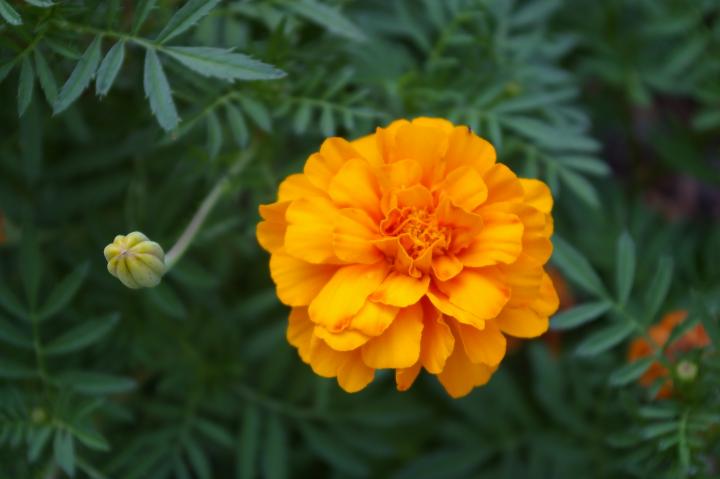
Close-up of an orange marigold.
Angela Altomare
Where to buy marigold seeds and plants: Burpee Gardening
No annual is more cheerful or easier to grow than marigolds. These flowers are the spendthrifts among annuals, showing a wealth of gold, copper, and brass into our summer and autumn gardens. The flower’s popularity probably derives in part from its ability to bloom brightly all summer long.
Marigolds have daisy-like or double, carnation-like flowerheads and are produced singly or in clusters. Although there are some 50 species, some marigolds we know come from just three:
- Tagetes erecta are the tallest, at three to five feet. They are sometimes known as African, or American, marigolds.
- Bushy T. patula, or French marigolds, are somewhat smaller and more compact. Elegant and eye-catching, they have relatively demure flowers and usually grow from 6 inches to 2 feet tall.
- The dainty T. tenuifolia are the signet, or rock-garden, marigolds that like hot, dry sites and make a wonderful edging. Their flowers are edible.
Marigolds have been sterotyped but they offer tremendous variety; some have fantastic aroma; all marigolds are good in containers and provide long-lasting cut flowers.
Planting
- Marigolds need lots of sunshine.
- Though they grow in almost any soil, marigolds thrive in moderately fertile, well-drained soil.
- Sow them directly into the garden once the soil is warm, or start seeds indoors about a month to 6 weeks before the last spring-frost date.
- The seeds germinate easily, but watch out for damping off if you start them inside.
- Separate seedlings when they are about 2 inches tall. Plant them in flats of loose soil, or transplant them into the garden.
- Space tall marigolds 2 to 3 feet apart; lower-growing ones about a foot apart.
- If planting in containers, use a soil-based potting mix.
Care
- Germination from large, easily handled seeds is rapid, and blooms should appear within a few weeks of sowing.
- If the spent blossoms are deadheaded, the plants will continue to bloom profusely.
- When you water marigolds, allow the soil to dry somewhat between watering, then water well, then repeat the process.
- Do not water marigolds from overhead. Water at the base of the plant.
- Do not fertilize marigolds. Too rich a diet stimulates lush foliage at the expense of flowers. Marigolds bloom better and more profusely in poor soil.
- The densely double flowerheads of the African marigolds tend to rot in wet weather.
Pests/Diseases
Farmers and gardeners have long known that marigolds make important companion plants all over the garden. Not only does the scent of the marigold (Tagetes spp.) repel animals and insects, but the underground workings of the marigold will repel nematodes (microscopic worms) and other pests for up to 3 years. They are especially helpful as deer-resistant plants.
Marigolds themselves are hearty but may be prone to gray mold, bacterial leaf spot, powdery mildew, Alternaria leaf spot, damping off, and root rot.
Harvest/Storage
- In flower arrangements, strip off any leaves that might be under water in the vase; this will discourage the overly pungent odor.
- Marigolds can be dried for long-lasting floral arrangements. Strip foliage from perfect blossoms and hang them upside down.
Wit & Wisdom
- In the late 1960s, Burpee president David Burpee launched an energetic campaign to have marigolds named the national flower, but in the end, roses won out.
- For years, farmers have included the open-pollinated African marigold ‘Crackerjack’ in chicken feed to make egg yolks a darker yellow.
- Marigolds are one of the October birth flowers.
Cooking Notes
- The bright petals of signet marigolds add color and a spicy tang to salads and other summer dishes.
- The flower petals are sometimes cooked with rice to impart the color (but unfortunately not the flavor) of saffron.
- ‘Mexican Mint’ (sometimes called Texas tarragon) is a study little herb that can be substituted for French tarragon in cooking. This species has been long used in Latin America for tea as well as seasoning.






